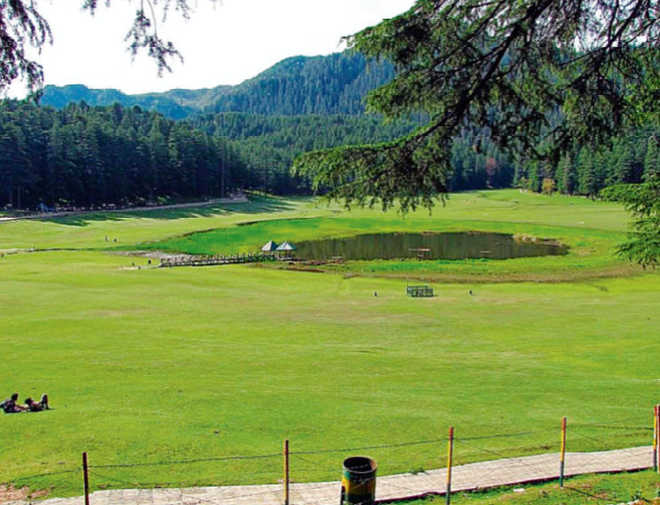Chamba tourism: Vast potential, poor marketing
Balkrishan Prashar
Developing Himachal Pradesh, which is endowed with natural scenery, greenery, pasturelands, and itineraries for trekkers and passes surrounded by snowy peaks, has always been the goal of the government and to achieve these development parameters and target, it keeps formulating and implementing various schemes and projects.
After independence, tremendous achievements have been made in terms of different development parameters. However, much needs to be done. Tourism activity promotion is an important strategy to target the economic and social backwardness and to accelerate the moving wheel of development in an area.
Chamba has remained backward in comparison to other districts of Himachal Pradesh and now, tourism can play an important role in bringing the economic status of its residents on a par with that of other districts.
Till now, tourism has remained an activity in the district concentrated in and around Dalhousie, whereas despite vast cultural diversity and unique heritage in terms of folk, tradition, cuisine and arts and crafts, its interior region, including Salooni, Churah, Bharmour, Mehla, Pangi, has remained devoid of development.
Around 7-10 lakh tourists visit Chamba district annually and about 95 per cent of them visit in and around Dalhousie only. Only a few tourists visit other parts of Chamba. Approximately 5-7 lakh pilgrims visit Manimahesh shrine in September each year and 90 per cent of them visit the holy lake of Manimahesh on two shahi snan (main holy bath) at the lake.
A large number of people visiting Manimahesh lake in Bharmour for 15 days has little impact on the economy regarding tourism point of view because the visit of a large number of pilgrims for a short span creates problem of traffic congestion, crowd management and the available resources are put on stress during these days.
One of the hoteliers of the area, SP Dhall has urged the government to introduce heli-taxi service from the nearby airports of Gaggal (Kangra), Amritsar and Chandigarh to promote tourism in a big way.
Surprisingly, in the past few years, it has been noticed that tourists are willing to visit the interiors of Chamba, including Salooni, Kihar, Bairagarh and Saach Pass of Pangi tribal valley. However, to facilitate the visit of tourists in these areas, infrastructure in terms of rooms for night stay is still insufficient and creates hindrance in boosting tourism activities.
The Department of Tourism is planning to promote rural tourism in these areas, in which “home stay” scheme notified by the government of Himachal Pradesh in 2008 needs to be popularised. A cluster will be identified in which 15-20 room capacity will be created as home stays with different households. Old wooden house constructed in traditional hill architecture, which are suitable for human habitation will be given preference,” says an official of the HP Tourism Department, while elaborating the tourism plans.
In addition to night stay facility, a group of rural youth will be orgainsed to showcase cultural heritage, tradition, faith, farm activity (farm tourism), local cuisine, flora and fauna of rural area. Activities such as adventures sports, sightseeing, trekking and camping can also be added. Such rural-based tourism can be an additional attraction for both domestic and foreign tourists.
The infrastructure which is community based will be funded by the government and individual infrastructure will be developed by the persons concerned. Rural tourism is a community driven and responsive tourism, in which 100 per cent benefit will be reared by the rural community.
“It will not only boost rural economy, but also help in preserving and promoting cultural heritage and tradition of this hill region. Local farm products and handicraft will also be promoted, which will not only lead to sustainable development, but will also be environment friendly,” an official said.
“At present, the problem is marketing. Big hoteliers can spend money to visit travel fairs in different parts of the country, but it is not possible for home stay owners to visit such travel fairs. The government should finance their visit to travel so that they can do marketing or can establish stall for home stays in such fairs,” says Hem Raj Chandel of Sanghni area in the district, who is an entrepreneur associated with the home stay business.
There is also a need to create a dedicated mobile application for home stay registration and marketing, they feel.
At present, the problem is lack of marketing. Big hoteliers can spend money to visit travel fairs in different parts of the country, but it is not possible for home stay owners to visit such travel fairs. The government should finance their visit to travel so that they can do marketing or can establish stall for home stays in such fairs. Hem Raj Chandel, An entrepreneur running a home stay unit in Sanghni area
The Tourism Department is planning to promote rural tourism. It will not only boost rural economy, but also help in preserving and promoting cultural heritage and tradition of this hill region. An official









